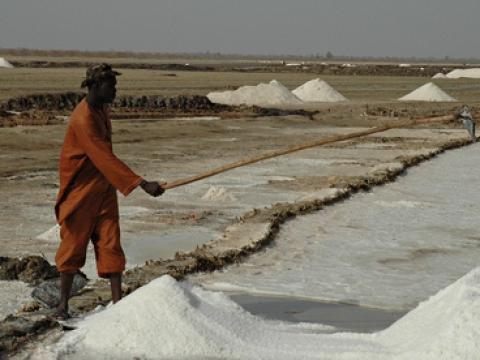The micronutrient distribution challenge

Dibocor strides across the salt plain on the outskirts of his village in Farabougou in the Kaolack region of Senegal wearing the contented smile of a man who has done his bit for his community. Dibocor is a proud user of a portable salt iodising machine, and he now knows that the few thousand bags of salt that he makes each year on his salt pan are properly iodised.
Back in 1985 the world's health authorities agreed a programme of salt iodisation to help the billions of people suffering from iodine deficiency, the main cause of preventable brain damage and reduced IQ in children worldwide. The major salt factories were updated quite quickly but the hardest part of their programme – reaching out to the estimated 20,000 small-scale salt processor – is ongoing. Unicef estimates that 30% of households in the developing world are not consuming iodised salt, and that these households include 41 million infants and newborns who are therefore not protected.
Staff from the Micronutrient Initiative (MI) have been working with small salt manufacturers such as Dibocor since 1992, helping them to iodise their salt properly. Mark Fryars from MI, explains that working in Senegal was crucial because Senegal is "one of a couple of countries that export salt to the rest of Africa". MI helped develop the iodisation machine on wheels that Dibocor now uses.
The MI estimates that as many as 50 countries could prevent the loss of intellectual capacity by 15% if young children, newborns, and pregnant mothers received enough iodine. "Iodine is needed in very small quantities for growth, brain function and development – it's needed in the womb to reduce fetal abnormalities," says Fryars.
But the strategy for addressing iodine deficiency – fortifying the salt that is used by the whole population – won't work for some of the other vitamins and minerals that people are deficient in. For example, there isn't a food that can be adequately fortified with vitamin A.
"Vitamin A can't be added to salt, it can be added to sugar but not in sufficient quantity, but one in three children in developing countries are deficient in Vitamin A which affects their immune system," Fryars said. "So vitamin A has to be a supplement, and it has to be administered."
To do this MI have developed a high strength vitamin A gel which is given to children twice a year. Vitamin A is stored in the liver, so twice yearly doses are enough.
The challenge for vitamin A is distribution. Fryars worked with Unicef on this. "We consolidated the orders of 75 countries to create demand for the high strength gel capsules. A small country like Senegal wouldn't buy enough of the capsules for itself," Fryars said, but by consolidating the orders of several neighbouring countries, MI has helped factories to open up and produce micronutrient supplements.
The Global Alliance for Improved Nutrition (Gain) also works on the production and distribution of micronutrients. Dominic Schofield, Gain's director, says there are three steps to getting a scheme up and running: You have to get government backing by showing them scientific evidence, develop the product and enable manufacturing and then stimulate demand and distribute. One of the key elements of this is finding families that need support in nourishing their babies and engaging with them.
An example of this is Gain's work with a company called Renata that produces micronutrient sprinkles, which can be added to the baby's portion of food in order to give them minerals that aren't available in the 'family pot'. Gain then put Renata in touch with the Bangladeshi NGO, Brac, who work with 97,000 community health workers at village level. The health workers, known as shasthya shebikas, distribute the micronutrient sachets and encourage pregnant women and the mothers of newborns to add them to food.
Schofield is an advocate of this kind of market-based system which he believes enables the widest distribution of the nutrients. "Brac guarantees the purchase of significant amounts of the sachets, which reassures Renata that it has a customer for these products, and then the shasthya shebikas earn a small amount of commission based on the amount that they sell."
"Renate sold 60m sachets across Bangladesh last year, 47 million were purchased by the poor themselves through the shasthya shebika network."
Ultimately, whether through 'whole population fortification' or through targeted supplement distribution, policymakers and donors will have to decide what steps must be taken to ensure that the poorest communities have access to the micronutrients needed for development.
Child Health Now is working to mobilise citizens around the world in order to increase education, awareness and the distribution of life-saving micronutrients such as iodine. Learn more about how you can get involved HERE.
*Original article posted by Frederika Whitehead, in The Guardian. See the original HERE.